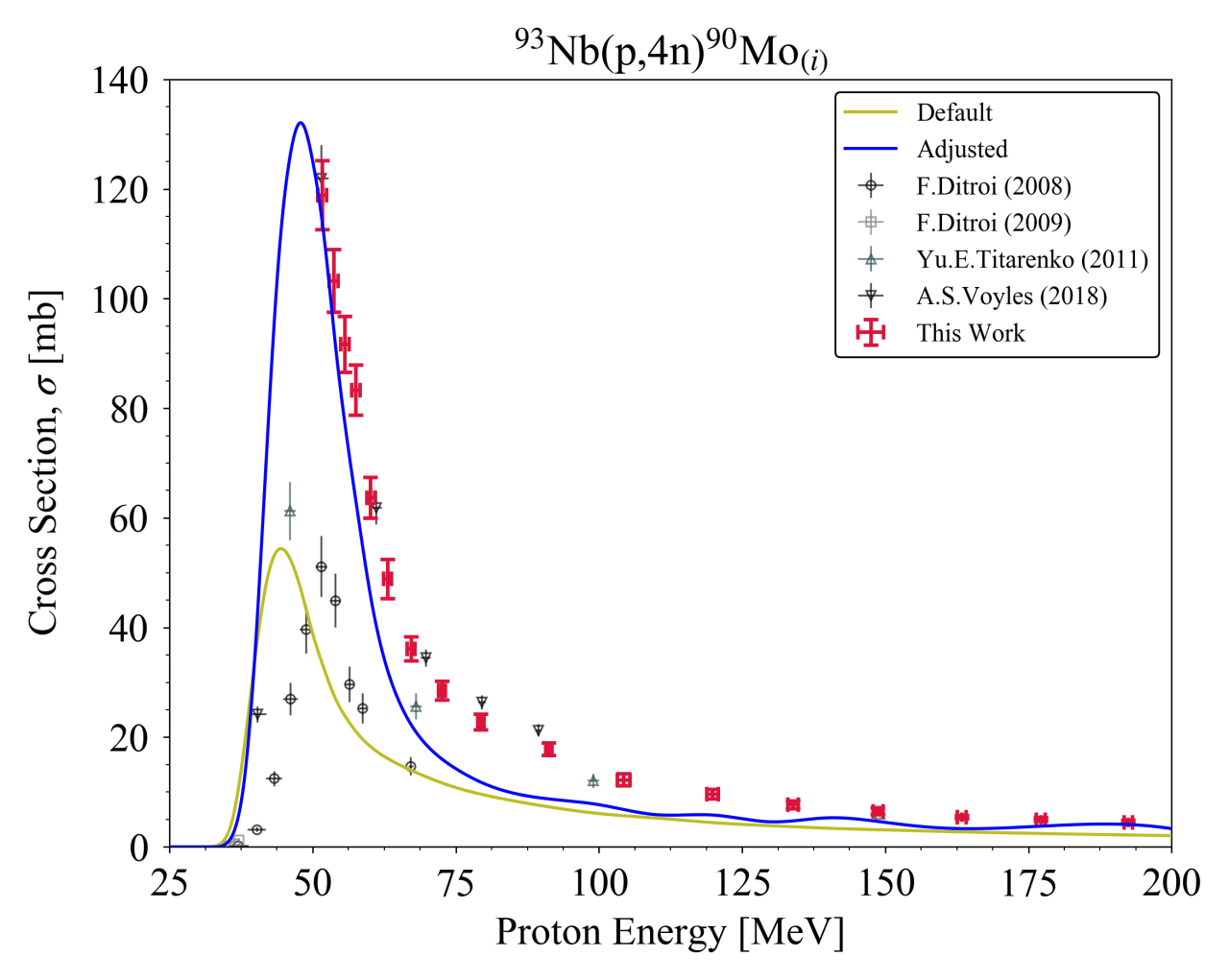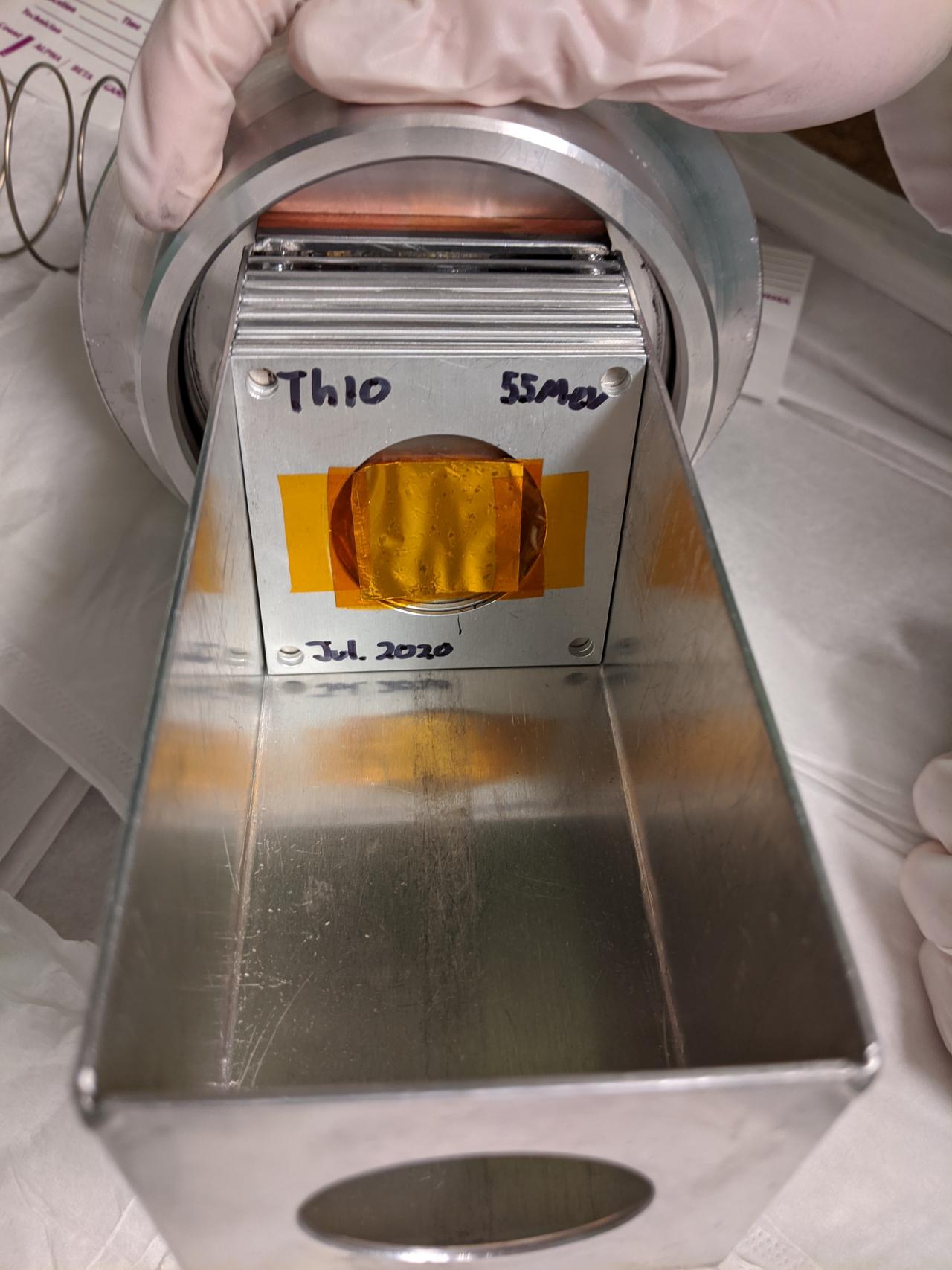Our program works on producing well-characterized, precision reaction data measurements, using “variance minimization” techniques to reduce the systematic uncertainties which often plague such measurements. Well-characterized data is necessary for improving our reaction modeling capabilities, but also has numerous applications in science and engineering.
One method that our program frequently uses for these precision measurements is the "stacked-target" activation technique. In this method, a stack of thin foils is irradiated by a charged-particle beam, along with a set of well-known "monitor reaction" foils. Based on the relative activation in each foil, a production cross section can be deduced using the monitor foils as a reference. A few examples of measurements performed using this technique are given below:

Nb monitors
Accurate cross section measurements using activation methods benefit from well-characterized monitor reactions, used to measure beam current through activation. Currently there is a paucity of such data at intermediate energies, and much of what exists have high uncertainties (>15%). Indeed, the development of new monitor reaction standards and the improved evaluation of existing standards is one of the areas of greatest cross-cutting need for nuclear data. Desirable monitor reactions possess several hallmark characteristics, including intense, distinct gamma-rays, which can be used for unique identification during post-activation assay, and lifetimes long enough to enable removal after a reasonable length irradiation. Care should also be taken to avoid cases where two radionuclides which are produced by two different reactions on the same monitor foil lead to states in the same daughter nuclide. Finally, of particular importance for facilities with energetic beams, it is of utmost importance to choose a reaction channel which cannot be populated via secondary particles incident upon the monitor target.
One reaction which satisfies these requirements is that of a new, intermediate-energy proton monitor reaction standard based on 93Nb(p,4n)90Mo. Niobium is commercially available, easy to machine, and 90Mo(t1/2 = 5.56 h) possesses a wide range of unique gamma rays which can be used to easily and leisurely measure beam current. It is also immune from activation via secondary neutrons, making it particularly suited as a beam monitor for facilities including LANL's LANSCE-IPF, and BNL's BLIP. The measurement of the 93Nb(p,4n)90Mo reaction has played a supporting role in this collaboration, as all experiments performed to date have included niobium monitors, to characterize it relative to existing monitor standards.

229Pa Generator
Similarly to the 226Ra(n,2n)225Ra approach, 225Ac can be produced free of long-lived radiocontaminants through production of a decay precursor. When a long-lived precursor exists, this approach yields a generator which can be milked for 225Ac on demand. The current domestic stockpile of 225Ac for research applications is currently produced using this approach, collected from the decay of the long-lived isotope 229Th (t1/2 = 7932 y, α). However, this necessitates large quantities of 229Th, which itself is a decay product of 233U [t1/2 = (1.592 ± 0.002) x 105 y] and can be obtained from stockpiles of this very long-lived isotope of uranium. However, 233U is difficult to produce, and the current worldwide annual supply is insufficient to meet the expected demand for 225Ac as clinical trials are expanded in an effort towards FDA approval.
As an alternative, 229Th for 225Ac generator material may be routinely produced using low-energy accelerators. In this project, the Isotope Production Group is collaborating with the Nuclear and Radiochemistry group at Oak Ridge National Laboratory, to explore 229Th production via Th(p,xn) and Th(n,xn) routes. The ORNL team has made prior measurements of several of these production routes previously, but this collaboration seeks to vastly expand both the energy range of these measurements, as well as make measurements of new production channels, leveraging the variable capabilities of the LBNL 88-Inch Cyclotron. This project will optimize production pathways for routine 229Th production, greatly expanding the potential supply of clean 225Ac for R&D studies. In addition, the recovery of 225Ac from thorium-based targets is both easier, faster, more efficient, and cheaper than separation from the Ra-based targets used in direct 225Ac production, due to the frequency and complexity of chemical processing steps required in the latter routes.
236mNp.png)
236Np/236Pu Calibration Standards
Neptunium-236 is a unique actinide isotope with use in metrology and analytical chemistry applications. Since it is neither anthropogenic nor primordial in occurrence, 236Np constitutes a reference standard for isotope dilution mass spectrometry with the function of improving accuracy and precision for the detection of common neptunium isotopes associated with nuclear energy applications. Isotope dilution is the method of adding a uniquely uncommon isotope of the element whose concentration is to be determined in known amounts to the unknown specimen. Quantification of the relative abundance of the added diluent isotope versus the unknown isotope enables the amount of analyte in the sample to be accurately determined. Isotope dilution mass spectrometry (IDMS) methods, including thermal ionization mass spectrometry (TIMS) and multi-collector inductively-coupled plasma mass spectrometry (MC-ICP-MS), are currently the most sensitive methods for measuring actinides in environmental samples. For quantitative results, an isotope dilution tracer is added to each sample and the ratio of the analyte to the tracer is used to calculate the amount of analyte in a given sample. An ideal IDMS tracer is an isotope that is not found in the sample and is stable or has a long half-life.
However, the current inventory of 236gNp (t1/2 = 1.53±0.05 x 105 y) is extremely limited, with the world-wide stockpile limited to 10’s of μg of material. The existing U.S. inventory was produced at Argonne National Laboratory in the mid-1980’s, via the reaction 235U(d,n) 236gNp using a 20 MeV deuteron beam. No effort was made to optimize irradiation conditions to minimize co-production of 237Np or to evaluate alternative production routes. As a result, the current 236g Np stock contains approximately 20% of 237Np (atom %) impurity, which negatively affects both the analytical uncertainty and detection limit for 237Np. Since the small amount of remaining material is currently available only for use as an isotope dilution tracer for 237Np determination in high-value samples, it is clear that a new supply of 236gNp tracer is critical to meeting the needs of the applications community. In 2015, the U.S. Certified Reference Materials (CRM) committee’s 236gNp working group identified an annual requirement of 10-20 μg / y, with a minimum 93.3 atom% 236gNp content. An exact knowledge of 235U(d,x)235,236,237Np reaction cross sections and threshold energies leads to 236gNp production with maximal yield and isotopic purity. Therefore, as part of a larger campaign to address deficiencies in cross-cutting nuclear data needs, our program has measured the nuclear excitation functions of the radionuclides 236Np and 237Np using a combination U(d,x) and U(p,x) production pathways.